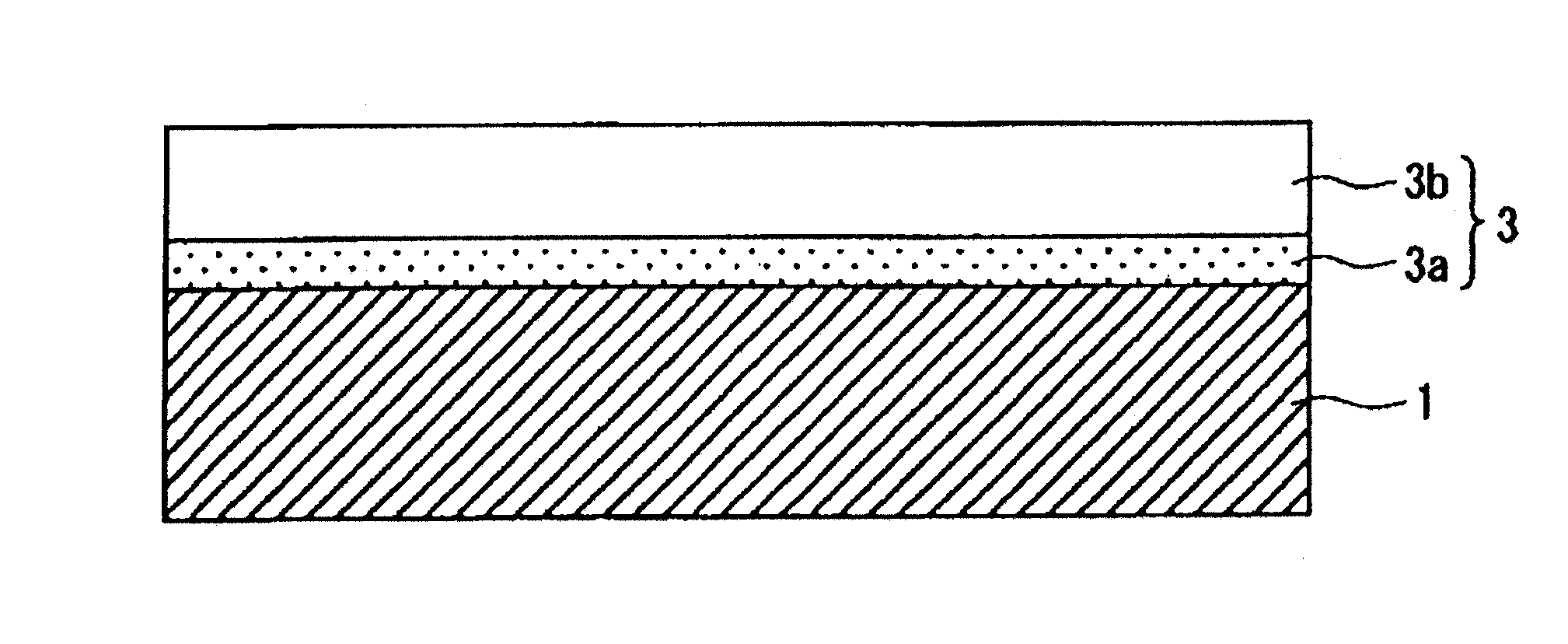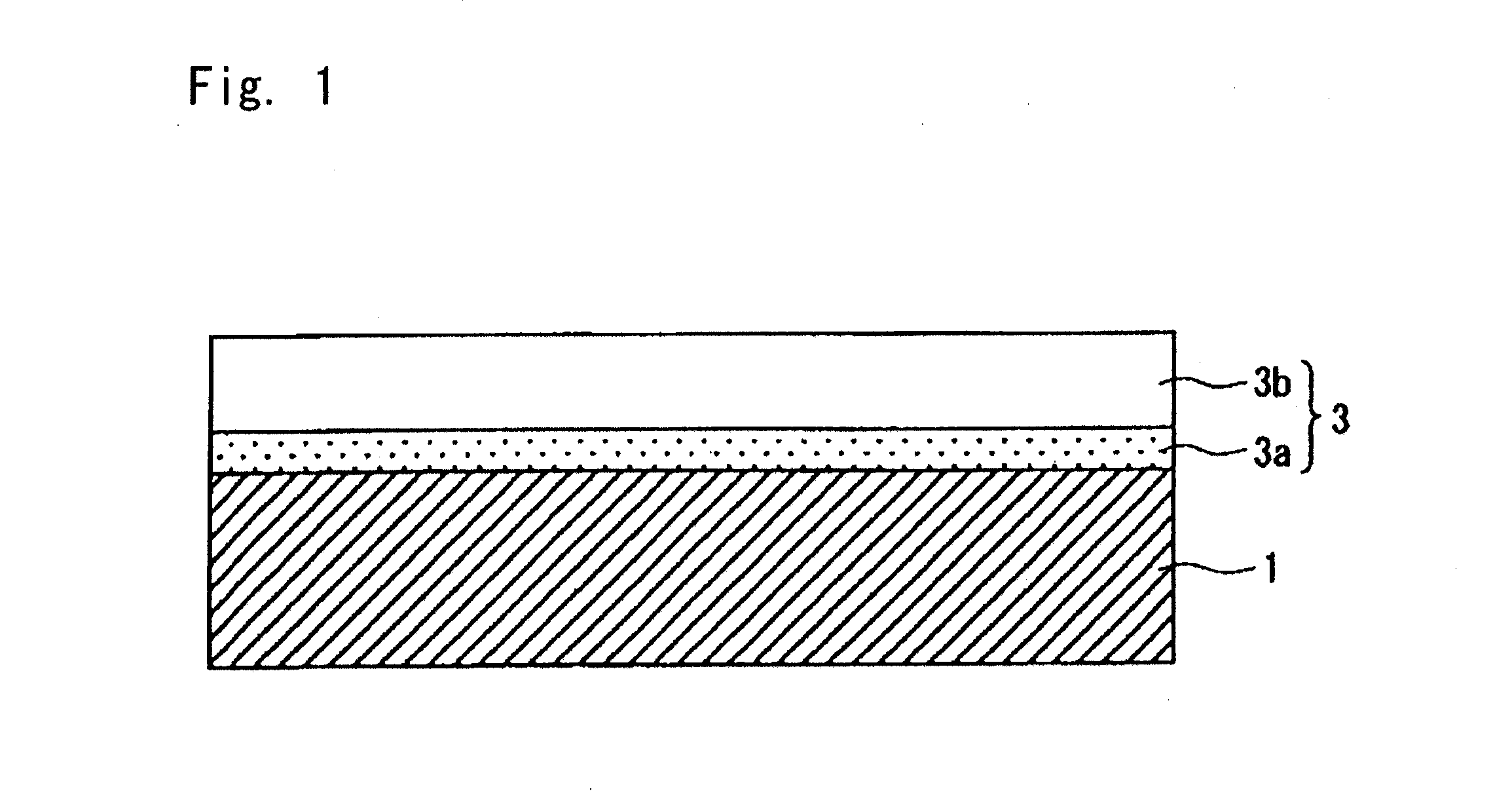[0030]In the present invention, the film vacuum-evaporated on the inner surface of the container wall such as of a bottle of a biodegradable resin is a hydrocarbon vacuum-evaporated film having, as shown in FIG. 1, a two-layer structure comprising a first hydrocarbon vacuum-evaporated layer (3a) formed on the surface of the container wall 1 and a second hydrocarbon vacuum-evaporated layer (3b) formed thereon which are formed by a plasma CVD within short periods of time. Therefore,
thermal deformation of the container can be effectively avoided even when the film is formed on the inner surface of the wall of the biodegradable resin container such as of a polylactic acid having a low
glass transition point and a low
heat resistance.
[0031]According to the present invention, further, the first hydrocarbon vacuum-evaporated layer (3a) into which are introduced polar groups as represented by the OH groups exhibits excellently close adhesion to the inner surface of the wall of the container. That is, the biodegradable resin such as the polylactic acid has a higher
carbonyl group (>C═O) concentration than that of the PET, and the first hydrocarbon vacuum-evaporated layer (3a) into which are introduced polar groups (—OH, —COOH, etc.) as represented by OH groups forms a
hydrogen bond between the
carbonyl group of the polylactic acid base material and the OH group of the vacuum-evaporated film, exhibiting excellent
bonding strength and excellently close adhesion between the inner surface of the biodegradable resin wall and the vacuum-evaporated film.
[0032]Here, as described earlier, if an aqueous content is filled and preserved in a conventional polylactic acid bottle having a hydrocarbon film vacuum-evaporated on the inner surface thereof, a problem arouses in that the film peels off. The peeling of film is a problem specific to the polylactic acid that occurs when a hydrocarbon film is formed on the container made from the polylactic acid and when an aqueous content is filled and preserved therein.
[0033]According to the present invention, however, upon introducing polar groups such as OH groups, the first hydrocarbon vacuum-evaporated layer (3) formed on the inner surface of the container wall forms a
hydrogen bond on the surface of the container wall to maintain highly close adhesion to the surface of the container wall. This makes it possible to effectively avoid the peeling of film on the interface between the inner surface of the container wall and the first hydrocarbon vacuum-evaporated layer irrespective of properties of the content, i.e., irrespective of oily or aqueous content that is preserved therein.
[0034]The first hydrocarbon vacuum-evaporated layer (3a) is capable of effectively avoiding the problem of peeling of film that occurs when an aqueous content is filled. However, as a result of introducing polar groups such as OH groups, the vacuum-evaporated film exhibits decreased barrier property against the water and
oxygen. When an aqueous content is filled, in particular, the required water-barrier property cannot be maintained. However, the present invention has a second short-chain branched hydrocarbon vacuum-evaporated layer (3b) of a hydrocarbon structure containing CH groups, CH2 groups and CH3 groups at predetermined ratios but without containing polar group, that is formed on the first hydrocarbon vacuum-evaporated layer (3a) realizing excellent barrier property against
oxygen and water irrespective of oily or aqueous content that is preserved.
[0035]That is, the second hydrocarbon vacuum-evaporated layer (3b) has no polar group such as OH group. Introduction of polar groups into the hydrocarbon vacuum-evaporated film decreases its barrier property against oxygen and water. However, this hydrocarbon vacuum-evaporated layer contains no polar group and avoids a decrease in the barrier property. Further, the second hydrocarbon vacuum-evaporated layer (3b) exhibits peaks
stemming from CH, CH2 and CH3 in a region of wave numbers of 3200 to 2600 cm−1 as measured by FT-IR. Reference should be made, for example, to FIG. 3 which is an FT-IR chart of the second hydrocarbon vacuum-evaporated layer in the vacuum-evaporated film on the polylactic acid base material prepared in Examples described later. FIG. 3 shows a peak
stemming from the CH3 bond in a non-asymmetric oscillation mode at a wave number of 2960 cm−1, a peak stemming from the CH2 bond in the non-asymmetric oscillation mode at a wave number of 2925 cm−1 and a peak stemming from the CH bond in the non-asymmetric oscillation mode at a wave number of 2915 cm−1. By giving attention to the absorption peaks in the same oscillation
modes as the non-symmetric oscillation
modes, the second hydrocarbon vacuum-evaporated layer (3b) of the present invention is a short-chain branched hydrocarbon film having a composition in which the CH2 ratio is not larger than 35% and the CH3 ratio is not smaller than 40% as calculated based on the peak intensities after having been corrected by absorbency coefficients (as for the detailed calculation method, refer to Examples). Upon forming the second hydrocarbon vacuum-evaporated layer (3b) having the above composition on the first hydrocarbon vacuum-evaporated layer (3a), oxygen-barrier property and water-barrier property are markedly improved as compared to those of when a conventional DLC film is formed.
 Login to View More
Login to View More 


